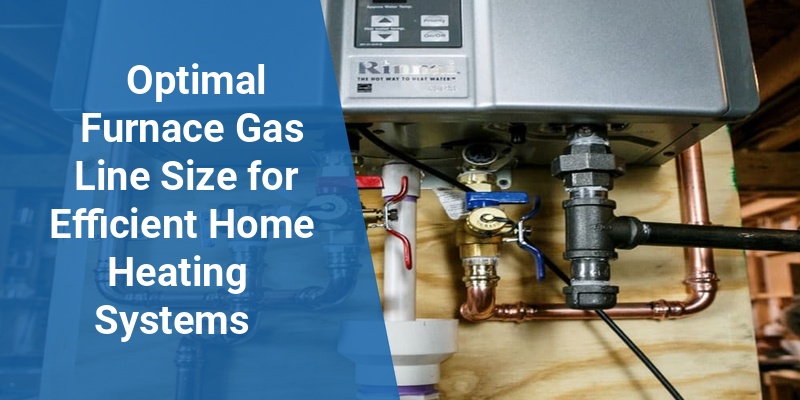Choosing the correct furnace gas line size is crucial for ensuring your home’s heating system operates safely and efficiently. An improperly sized gas line can lead to insufficient heating, increased energy bills, or even potential safety hazards. This article explores how to determine the appropriate gas line size for residential furnaces, the factors affecting sizing, and installation best practices to maintain performance and safety.
| Gas Line Size | Typical Usage | Max Gas Flow Capacity (CFH) |
|---|---|---|
| 1/2 Inch | Small furnaces and appliances | Up to 140 CFH |
| 3/4 Inch | Most residential furnaces | Up to 240-300 CFH |
| 1 Inch | High capacity furnaces or multiple appliances | Up to 500+ CFH |
Understanding Furnace Gas Line Size and Its Importance
The furnace gas line size refers to the diameter of the pipe delivering natural gas or propane to a furnace. Proper sizing ensures that the furnace receives adequate gas pressure and volume. If the gas line is too small, the furnace might not get enough fuel, causing it to underperform or cycle irregularly. Conversely, oversized lines can be unnecessarily costly and complicated to install.
Gas line size affects:
- Performance: Adequate gas supply ensures optimal furnace operation.
- Safety: Proper sizing prevents gas leaks and pressure drops.
- Efficiency: Correct flow reduces energy waste and operational costs.
Key Factors Influencing Gas Line Sizing for Furnaces
Several critical factors determine the right gas line diameter:
- BTU Rating of the Furnace: The British Thermal Unit (BTU) rating indicates furnace energy consumption, guiding the supply needs.
- Length of the Gas Line: Longer pipelines experience pressure drops, necessitating larger pipe diameters.
- Gas Pressure at the Meter: Standard line pressure impacts flow capacity and sizing requirements.
- Number of Appliances: Multiple gas-powered devices connected to one line require increased pipe size.
- Type of Gas: Natural gas and propane have different flow characteristics affecting pipe sizing.
How to Calculate the Appropriate Furnace Gas Line Size
Proper sizing involves calculating the gas demand and matching it with the pipe capacity. The typical steps include:
- Determine the furnace’s input BTU rating (usually found on the appliance label).
- Convert BTUs to Cubic Feet per Hour (CFH) for natural gas or pounds per hour for propane.
- Measure the total length of the gas piping from the meter to the furnace.
- Use gas pipe sizing charts compliant with the National Fuel Gas Code (NFPA 54) or manufacturer guidelines.
- Select the pipe diameter that delivers required CFH while compensating for length and pressure drop.
Example: A 100,000 BTU/hour natural gas furnace requires approximately 100 CFH. If the pipe must run 50 feet, a 3/4-inch pipe might be necessary to avoid pressure loss.
Common Gas Pipe Materials and Their Impact on Sizing
The type of material used for gas piping also influences line sizing and installation practices:
Call 888-906-9139 for Free Local HVAC Quotes – No Obligation, Just Savings!
- Black Steel: The most common, durable material for gas lines. Suitable for both indoor and outdoor use.
- Corrugated Stainless Steel Tubing (CSST): Flexible piping allowing easier installations, with specific sizing guidelines.
- Galvanized Steel: Less common due to corrosion issues but still used in some areas.
- Polyethylene (PEX) Tubing: Used mainly outdoors for underground gas lines; requires proper sizing and protection.
Installation Best Practices for Furnace Gas Lines
Proper installation ensures safety and performance compliance:
- Follow local codes: Compliance with local building and gas codes is mandatory.
- Permit and inspections: Obtain necessary permits and have installations inspected by qualified professionals.
- Use proper fittings and supports: Secure pipe connections with approved fittings and avoid bends that reduce flow.
- Test for leaks: Always perform pressure testing after installation using soapy water or a gas leak detector.
- Use correct venting and shutoff valves: Ensure access to shutoffs and proper ventilation to prevent gas buildup.
Signs of Incorrect Gas Line Sizing and When to Call a Professional
Homeowners should be aware of warning signs indicating gas line issues:
- Furnace not heating properly: Inconsistent heating or frequent cycling.
- Unusual noises: Hissing sounds near gas lines may indicate leaks or pressure problems.
- Yellow or flickering pilot light: Could signal insufficient gas flow or combustion issues.
- High energy bills: Overworking furnace caused by inadequate gas supply.
If these signs occur, contact a licensed HVAC technician or plumber immediately for inspection, sizing verification, and repair.
Benefits of Correct Furnace Gas Line Sizing
| Benefit | Details |
|---|---|
| Enhanced Safety | Prevents gas leaks and unsafe pressure levels. |
| Improved Efficiency | Ensures the furnace receives adequate fuel to operate efficiently. |
| Lower Energy Costs | Reduces wasted energy from inefficient furnace cycles. |
| Extended Equipment Lifespan | Prevents strain on furnace components and reduces breakdowns. |
Additional Resources for Furnace Gas Line Sizing
Homeowners and contractors can refer to the following authoritative sources for detailed guidelines:
